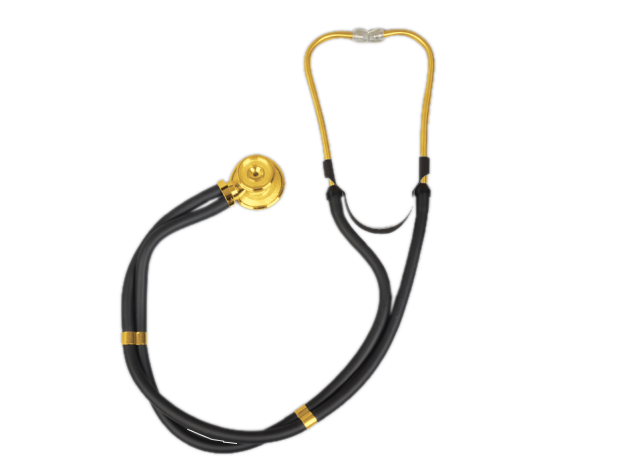
Sprague-Rappaport Stethosc
The Sprague-Rappaport Stethoscope was designed by Dr. Nathan Rappaport, a physician and inventor, in 1924. This stethoscope is different from many others because it has a second set of earpieces attached to the main body of the device.
Gold plated Head.
A Sprague-Rappaport stethoscope is a type of medical stethoscope that is designed differently than other types of stethoscopes. The main difference between a Sprague-Rappaport stethoscope and other types of stethoscopes is the way that the two earpieces are connected. Most stethoscopes have a single tube that connects the two earpieces, but a Sprague-Rappaport stethoscope has two tubes that connect the earpieces. This design allows for more flexibility and movement of the earpieces, which can be helpful when trying to position them correctly on the ears. Sprague-Rappaport stethoscopes are also typically longer than other types of stethoscopes, which can make them more comfortable to use for extended periods of time. Another advantage of the Sprague-Rappaport design is that it is less likely to break or come apart than other types of stethoscopes.
When it comes to stethoscopes, not all models are created equal. The Sprague-Rappaport stethoscope is designed differently than other models on the market, and this unique design offers a number of advantages for users. One of the biggest differences between the Sprague-Rappaport and other stethoscopes is the way in which the tubing is attached to the chest piece. On most models, the tubing is permanently attached to the chest piece, but on the Sprague-Rappaport, it can be removed and replaced as needed. This means that if one of the tubes becomes damaged, it can be easily replaced without having to buy a new stethoscope altogether. Another difference is that the Sprague-Rappaport has two separate earpieces which can be used interchangeably. This allows users to customize their experience depending on their needs at any given moment. If one earpiece is not working properly, simply switch to the other one – there's no need to fiddle with different settings or attachments. Finally, the Sprague-Rappaport stethoscope is made with high-quality materials that are built to last. This means that you won't have to replace your stethoscope as often as you might with a cheaper model. When it comes to choosing a stethoscope, quality should always be a top priority – and the Sprague-Rappaport delivers on that front .
The Sprague Rappaport stethoscope is designed for use in auscultation, which is the process of listening to the internal sounds of the body. This type of stethoscope has two diaphragms, one that covers the entire chest piece and another that covers only a small portion. The diaphragms are connected to each other with tubing, and the user can switch between them by depressing a valve on the side of the chest piece. When using this stethoscope, it is important to keep the ear tips clean and free of debris. The ear tips should also be inserted properly into the ear canal in order to create an airtight seal. To use the diaphragms, simply place the chest piece on the patient's skin and press down lightly. The sound will be amplified through the tubing and can be heard clearly by holding the ear tips close to your ears.
1. The Sprague Rappaport stethoscope can be used for a number of different things beyond just taking someone's blood pressure.
2. It can be used to listen to heartbeats, as well as lung and intestinal sounds.
3. It can also be used to check for blockages in arteries and veins, and to measure blood flow through them.
4. Additionally, the Sprague Rappaport stethoscope can be used to check for hernias, and to listen to bowel movements in order to determine if there are any blockages present.